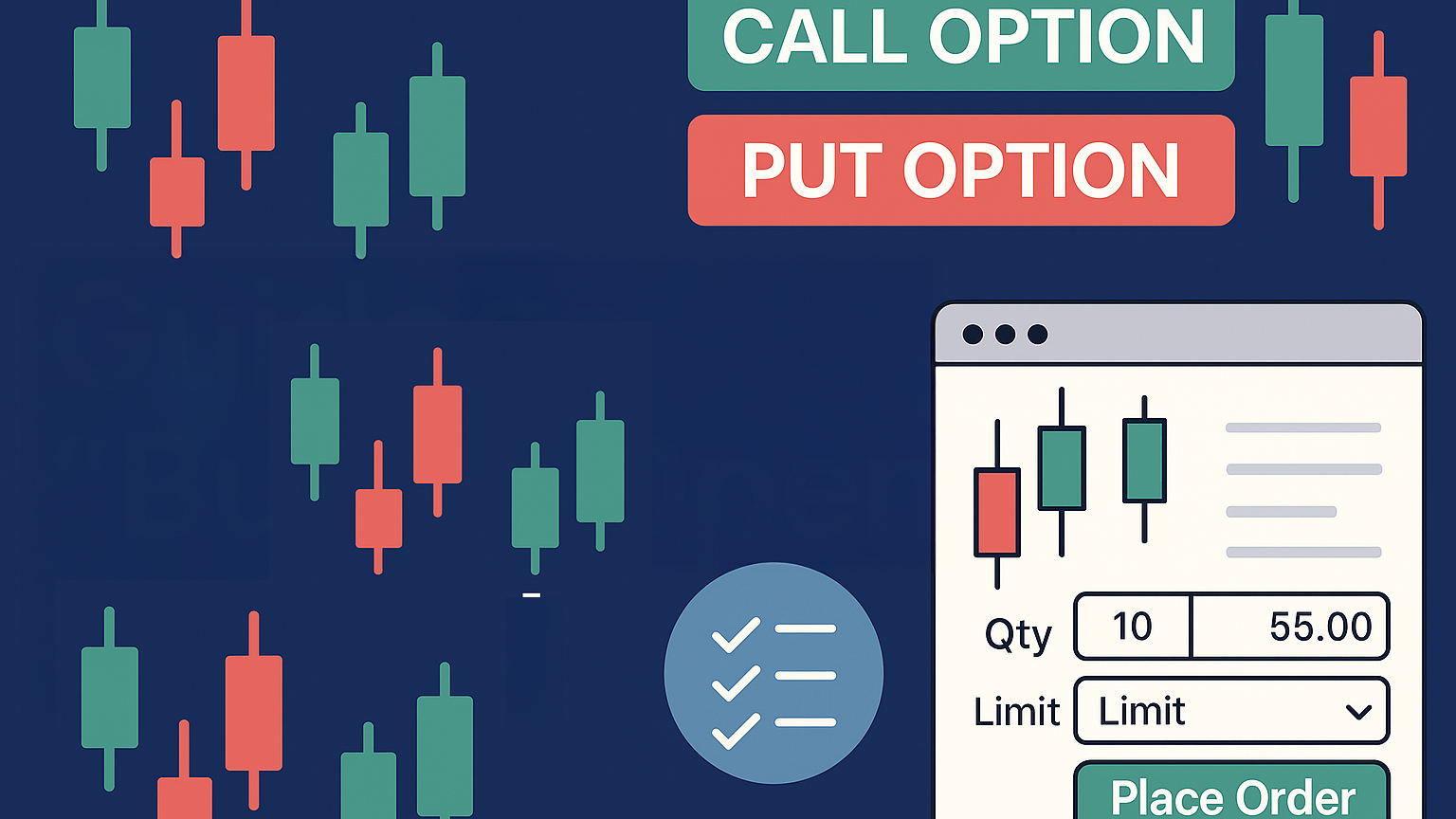Learn how 'Sell to Open' options trading can generate income through premium collection while managing associated risks effectively.
Want to earn income from options trading? "Sell to Open" might be the strategy you're looking for. It's a method where you sell options contracts to collect upfront premiums while managing risk. Here's what you need to know:
- What it is: "Sell to Open" creates a short position by writing new options contracts. You get paid a premium but take on obligations if the option is exercised.
- How it works: This strategy benefits from time decay, making it ideal for generating income. Common approaches include covered calls, cash-secured puts, and credit spreads.
- Risks: While profitable, "Sell to Open" carries risks like unlimited losses (naked calls) or the need for significant capital (cash-secured puts).
- Best practices: Focus on proper risk management, choose appropriate strike prices and expiration dates, and monitor your trades closely.
Quick Comparison of Strategies
| Strategy | Market Outlook | Key Benefit |
|---|---|---|
| Covered Calls | Neutral to Slightly Bullish | Earn income on owned shares |
| Cash-Secured Puts | Bullish | Buy stocks at lower prices |
| Credit Spreads | Direction-Specific | Limited risk, steady income |
If you're new, start with covered calls or cash-secured puts to minimize risk while learning. This article breaks down everything, from the basics to advanced tactics, so you can trade smarter.
Core Mechanics of 'Sell to Open'
Basic Options Components
A 'Sell to Open' trade revolves around three key elements. First, there's the premium, which is the upfront payment you receive as the option writer. Then, the strike price determines the level at which the option can be exercised. For instance, if you sell a call option with a $50 strike price, you’re agreeing to sell the underlying stock at $50 if the buyer exercises their right. Lastly, the expiration date defines how long your obligation lasts.
| Component | Description | Impact on Premium |
|---|---|---|
| Strike Price | Exercise level of contract | Further from current price = lower premium |
| Expiration | End date of contract | Longer time = higher premium |
| Volatility | Market price fluctuations | Higher volatility = higher premium |
With these basics in mind, let’s look at how buying and selling options differ.
Buying vs. Selling Options
These components underline the key differences in risk and reward between buying and selling options. The main distinction lies in the risk-reward tradeoff. When you buy an option, your risk is capped at the premium you paid. On the other hand, selling an option gives you immediate premium income but comes with potentially large obligations.
Here’s a quick comparison:
| Aspect | Option Buyer | Option Seller |
|---|---|---|
| Initial Cash Flow | Pays premium | Receives premium |
| Maximum Profit | Unlimited (calls) or limited (puts) | Limited to the premium received |
| Maximum Loss | Limited to the premium paid | Potentially unlimited for calls, significant for puts |
| Time Decay | Works against the position | Works in favor of the position |
For example, if you sell a put on a $100 stock with a $95 strike price and collect a $2 premium, you’ll earn $200 per contract. Your maximum profit is capped at the premium received. However, if the stock price drops to zero, your maximum loss would be (95 – 2) × 100 = $9,300. This example highlights why managing position sizes and assessing risk is so important when selling options.
A 'Sell to Open' position can result in one of three outcomes: the option expires worthless (ideal for the seller), the buyer exercises the option, or you close the position early by buying it back.
Pros and Cons of 'Sell to Open'
Main Benefits
'Sell to Open' allows traders to collect premiums upfront and take advantage of time decay, making it a popular choice for generating regular income when options expire worthless. This approach is ideal for investors aiming for steady portfolio returns through premium collection.
Key Risks
This strategy carries the risk of unlimited losses when selling naked calls, as significant price increases can quickly wipe out gains. Additionally, brokers often require higher margins for these positions, which can reduce trading flexibility and tie up capital. While higher volatility can lead to larger premiums, it also raises the likelihood of options being exercised. To better understand the contrasts, see the table comparing 'Sell to Open' and 'Buy to Open' strategies below.
'Sell to Open' vs 'Buy to Open' Comparison
| Aspect | Sell to Open | Buy to Open |
|---|---|---|
| Opening Position Flow | Immediate premium inflow | Immediate premium outflow |
| Maximum Profit | Limited to premium | Unlimited (calls) |
| Maximum Loss | Unlimited (calls) | Limited to premium |
| Time Value | Favorable decay | Adverse decay |
| Market Sentiment (Calls) | Bearish/neutral | Bullish |
| Market Sentiment (Puts) | Bullish/neutral | Bearish |
| Capital Requirements | Higher margin needed | Premium only |
| Volatility Impact | Benefits from decrease | Benefits from increase |
These differences in risk and reward make 'Sell to Open' a strategy suited for traders focused on income generation and experienced in handling the associated obligations. Active management is essential, especially to monitor margin requirements and the potential for assignment.
Cash Secured Puts Explained: Options Trading for Beginners
Common 'Sell to Open' Trading Methods
Let's dive into three practical trading strategies that use the 'Sell to Open' approach.
Writing Covered Calls
Covered calls can help you earn regular income from stocks you already own. To use this strategy, you need to hold at least 100 shares of a stock and sell call options on those shares.
This method works well in markets that are stable or slightly bullish, where there's limited potential for big price increases. For instance, if you own 100 shares of a stock priced at $50, you could sell a call option with a $55 strike price, set to expire in 30 to 45 days. The premium you collect provides immediate income and some protection against minor price drops. Many investors aim to collect premiums worth about 2% of the stock's value when choosing strike prices and expiration dates.
Selling Cash-Secured Puts
Selling cash-secured puts is another way to earn income, and it can also help you buy stocks at a lower price. This strategy requires you to have enough cash to purchase the stock if the option is exercised. It's most effective in markets that are steady or slightly bullish.
The premium you receive offers regular income if the option expires without being exercised. However, the main risk is that you may have to buy the stock at the strike price if its market value drops significantly.
"When you sell a cash-secured put, you earn a premium from selling a put (creating an obligation to buy the underlying security if the put option is exercised by the buyer)." - The Know Editors, J.P. Morgan Wealth Management
For those looking to manage risk, defined-risk setups like credit spreads can be a useful alternative.
Using Credit Spreads
Credit spreads combine selling and buying options with different strike prices but the same expiration date. The purchased option acts as a hedge, while the sold option allows you to collect a premium. This strategy benefits from time decay and doesn't rely on large price moves in the underlying asset. Many traders prefer spreads with 2-3 week expirations to take advantage of optimal premium decay.
Here are some common types of credit spreads:
| Spread Type | Market Outlook | Key Characteristic |
|---|---|---|
| Bull Put Spread | Bullish/Neutral | Sell a put, buy a lower strike put |
| Bear Call Spread | Bearish/Neutral | Sell a call, buy a higher strike call |
| Iron Condor | Neutral | Combine bull put and bear call spreads |
| Iron Butterfly | Highly Neutral | Tighter spread around a central price |
These strategies typically require less margin compared to writing naked options.
How to Place a 'Sell to Open' Trade
Selecting Your Stock or ETF
Start by picking a stock or ETF that fits your trading plan. Since most options expire worthless, focus on assets with steady price trends and high trading activity.
For covered calls, choose stocks you’re comfortable holding for the long term, especially those with predictable price movements. For cash-secured puts, make sure you have enough cash available to cover the potential assignment.
Picking Price and Date
Choosing the right strike price and expiration date is key. Data shows that 70% of in-the-money (ITM) options are profitable, compared to 30% for out-of-the-money (OTM) options.
Here’s a quick guide to strike price strategies:
| Market Condition | Strike Price Strategy | Key Considerations |
|---|---|---|
| Stable Market | At-the-Money (ATM) | Moderate premiums, higher chance of assignment |
| Bullish Market | Out-of-the-Money (OTM) | Lower premiums, reduced assignment risk |
| Volatile Market | In-the-Money (ITM) | Higher premiums, greater assignment risk |
When it comes to expiration dates, traders who adjust based on market shifts tend to achieve 15-20% better outcomes.
"The difference between a winning trade and a losing one often comes down to two critical decisions - strike price and expiration. Are you making the right choices?" - InsiderFinance Team
These decisions set the stage for your trade. Once you’ve made your selections, it’s time to execute.
Order Entry and Management
With your asset and trade details ready, the next step is placing and managing your order.
- Check Collateral Requirements
Ensure you meet your broker's requirements. For covered calls, this means owning 100 shares of the stock. For cash-secured puts, you’ll need enough cash to cover the potential purchase.
- Enter the Trade
Input your trade details carefully:
- The stock or ETF
- Option type (call or put)
- Strike price
- Expiration date
- Order type (limit orders are often recommended)
- Number of contracts
- Monitor and Adjust
Keep an eye on your position and make adjustments if market conditions shift. Treat any adjustment as a new trade, with clear profit and loss targets. Watch for factors like the option moving in-the-money or upcoming dividends that could lead to assignment.
When adjusting your position, align your strategy with current market trends and volatility. This approach helps balance risk and maintain steady returns.
Tips for Success with 'Sell to Open'
Managing Trade Size and Risk
Getting your position size right is crucial. Conservative traders often keep their exposure to 1.5–2 times their capital, while those willing to take on more risk might go up to 2–3 times their exposure. It's also wise to keep at least 40% of your funds as a safety buffer.
Here's a quick overview of a risk management plan:
| Risk Level | Maximum Position Size | Capital Reserve | Maximum Loss Per Trade |
|---|---|---|---|
| Conservative | 1.5X capital | 50% unused | 1% of portfolio |
| Moderate | 2X capital | 40% unused | 1.5% of portfolio |
Once you've sized your trades and accounted for risk, the next step is keeping track of your performance.
Trade Tracking and Adjustment
Keeping a detailed trade journal is a habit successful traders swear by. Record everything - entry and exit prices, position sizes, strike prices, market conditions, any adjustments you make, and the outcomes. Each market shift should be treated as a new opportunity for analysis.
Here are strategies for handling market changes:
| Market Change | Adjustment Strategy | Risk Impact |
|---|---|---|
| Sudden Reversal | Roll to a different strike | Reduces delta risk |
| Increased Volatility | Convert to a spread | Limits maximum loss |
| Time Decay | Add a hedge | Provides downside protection |
Exit Timing
Knowing when to exit is just as important as entering a trade. Pay attention to both technical and fundamental signals to decide when to close your position.
Key technical triggers include:
- Breaks of significant support or resistance levels
- Crosses of key moving averages
- Reversal patterns
On the fundamental side, watch for changes in company financials, shifts in market sentiment, or news events that could impact the asset you're trading.
Set clear profit targets and loss limits before you start. You might also consider scaling out of positions—taking partial profits at specific targets while adjusting stop-loss orders for the rest. This approach helps you lock in gains while managing risks effectively.
Conclusion
Main Points Review
"Sell to Open" is a core strategy in options trading, designed for generating income and managing risk. It allows traders to earn an upfront premium while leveraging time decay. However, success hinges on understanding market conditions and addressing associated risks.
| Strategy Component | Key Consideration | Impact |
|---|---|---|
| Premium Collection | Immediate income from option sale | Provides upfront cash flow |
| Time Decay | Works in seller's favor | Gradually reduces the option's value |
| Volatility Impact | Higher volatility increases premiums | Boosts income potential but adds risk |
| Risk Management | Requires margin or collateral | Protects against potential losses |
This table highlights how premium collection and proper risk management are critical to executing successful Sell to Open trades.
Getting Started
If you're new to this strategy, start with covered calls or cash-secured puts to minimize risk while gaining experience. Place Sell to Open orders at the bid price for faster execution, document each trade, and stick to disciplined position sizing and capital reserves to safeguard against losses as you explore advanced strategies.
Begin with small trades, focus on understanding how each step works, and gradually expand into strategies that align with your financial objectives.






